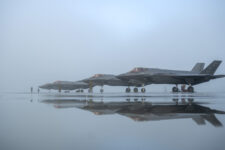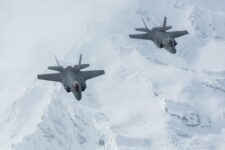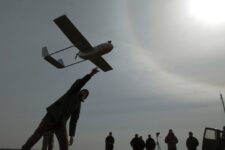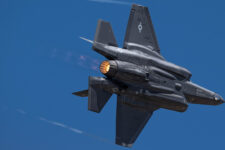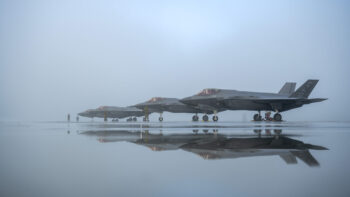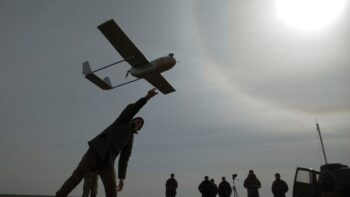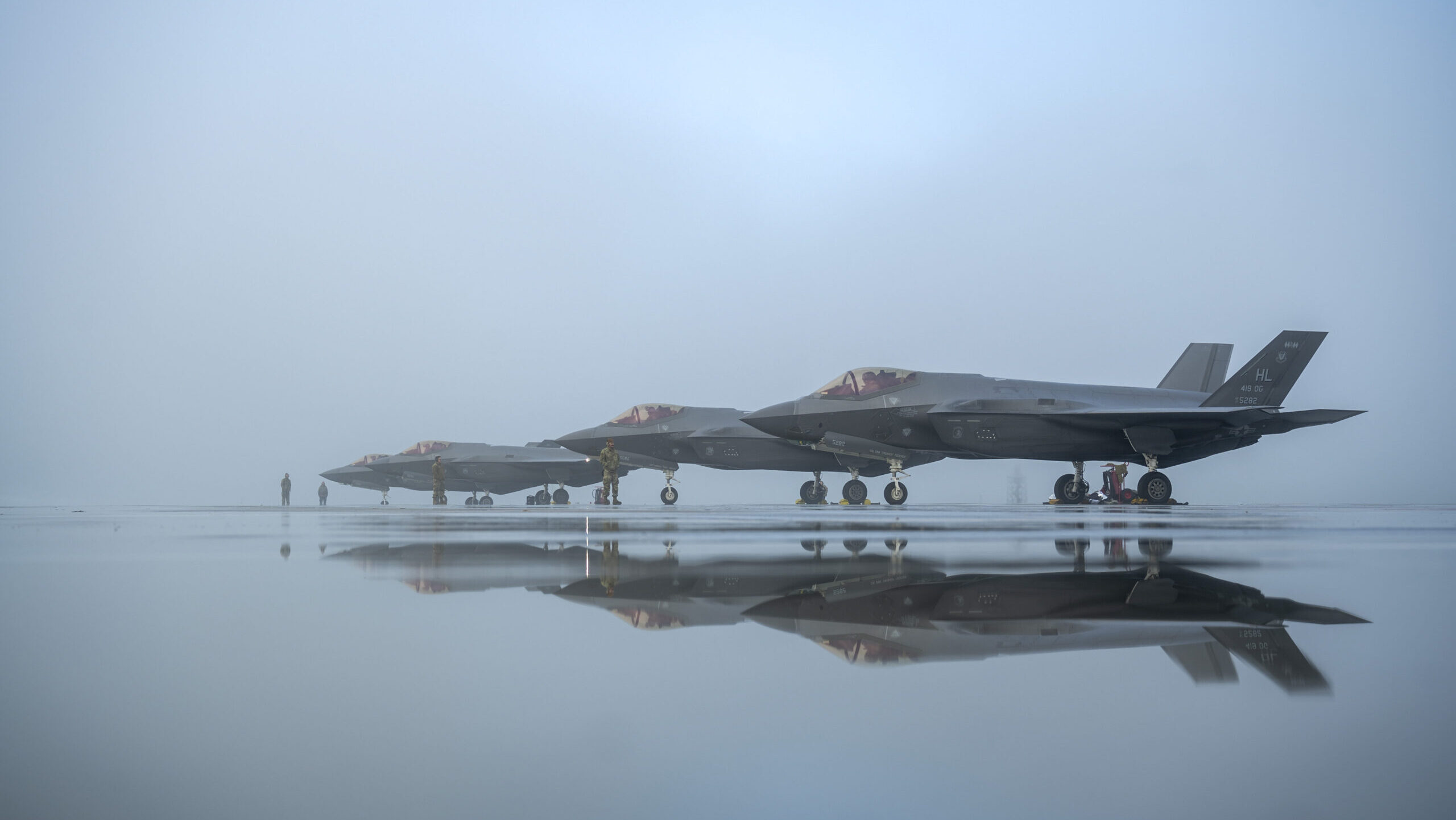
Airmen assigned to the 34th Fighter Squadron and Fighter Generation Squadron perform pre-flight checks on F-35A Lightning IIs at Mountain Home Air Force Base, Idaho, March 28, 2024. (U.S. Air Force photo by Airman Keagan Lee)
WASHINGTON — The Pentagon’s current National Defense Strategy is out of date, America’s military is inappropriately structured and the US industrial base is “grossly inadequate” to confront the dual threats of Russia and China, according to a new, high-powered formal review.
“The U.S. public are largely unaware of the dangers the United States faces or the costs (financial and otherwise) required to adequately prepare” for a global conflict, reads an early page from the final report of the Commission on the National Defense Strategy, published today. “A bipartisan ‘call to arms’ is urgently needed so that the United States can make the major changes and significant investments now rather than wait for the next Pearl Harbor or 9/11. The support and resolve of the American public are indispensable.”
The Commission was created by the fiscal 2022 National Defense Authorization Act to review that year’s NDS. Chaired by former Rep. Jane Harman, a previous ranking member of the House Intelligence Committee, the bipartisan committee’s report will likely be wielded — perhaps literally, as former Senate Armed Services Committee chairman Jim Inhofe regularly held up the 2018 version of the commission’s report at hearings — by supporters on the Hill who seek increased defense spending.
In a factsheet accompanying the report, Harman said, “DoD’s defense strategy was written before the wars in Ukraine and the Middle East and doesn’t account for the partnership between China and Russia. It is insufficient to meet the threats. We recommend a new approach, combining the U.S. military with the ingenuity of the tech sector; our influence through diplomacy and investment; and the resilience of the American people.”
Beyond laying out an alarming picture of America’s national security landscape, the 114-page report offers a number of recommendations to policymakers in the White House, strategists in the Pentagon and to lawmakers — largely taking an aggressive, more-of-everything approach. Boldest among the proposals is calling for a “Multiple Theater Force Construct” to fix the current, “out-of-date” version.
“The Commission believes the United States needs a force-planning approach that is both global and prioritized. … An exclusive focus on a single adversary or single region, as some have suggested, is a fundamentally flawed response to the global nature of challenges posed by such adversaries as China and Russia and to the growing cooperation between adversaries across regions,” the report says. “That said, the United States’ force-planning approach must be prioritized to effectively and efficiently allocate finite resources, address threats of varying scope and scale, and ensure a mix of U.S. instruments of national power that are tailored to specific strategic objectives.”
The Commission’s solution is “distinct from the two war construct designed after the Cold War for separate wars against less capable rogue states — essentially, one in northeast Asia and one in the Middle East” and “reflects the partnership of U.S. peer or near-peer adversaries, the U.S. system of alliances, and the need to engage globally.”
From there the report dives into changes it would make to the military services, including more ships and shipbuilding infrastructure for the Navy and more dispersed satellites for the Space Force. It also supports the Air Force’s pursuit of a Next-Generation Air Dominance fighter, a project with a murky future at the moment.
Regarding the Indo-Pacific theater, the Commission calls for more undersea assets — “particularly Virginia-class submarines but also large, uncrewed underwater vessels” — as well as more long-range bombers and long-range fires.
“The Commission is encouraged by recent agreements with regional allies and partners to expand U.S. access,” the report says. “But the Commission remains concerned by continued underinvestment in new and updated facilities in the First and Second Island Chains, as well as the lack of new forces postured west of the International Date Line.”
In Europe, the report says the NDS was wrong to call Russia, like many US officials have since, an “acute threat.” The term, it says, “underestimates the threat from Russia by implying it is intense but limited in duration.” Rather, the threat from Moscow is “chronic,” the report says, “ongoing and persistent.”
To counter the Kremlin in the wake of its invasion of Ukraine, the Commission says the “only viable course of action is to increase the scale, capability, and freedom to use material provided to Ukraine so that it can push Russia back.”
It also calls for the US to “boost its forward presence in Eastern Europe — built around an armored corps and complete with headquarters, fires, air defenses and armored, sustainment and aviation units — to deter Russian aggression against NATO’s eastern flank.”
“Ultimately,” it says, “the goal is for Europe to take on a larger role in providing for its defense, with assured and critical support of the United States. In light of the potential for simultaneous conflicts, capability targets apportioned to European allies through the NATO Defense Planning Process should be intentionally selected to reduce overreliance on the United States for key capabilities enablers.”
Industrial Call To Action
When it comes to the US defense industrial base (DIB), the report does not mince words: “[T]oday, the United States has a DIB with too few people, too few companies, declining and unstable financial support, and insufficient production capacity to meet the needs of the joint Force in both peacetime and wartime.”
The report specifically calls out DIB weakness when it comes to shipbuilding for the Navy, saying that service’s ability to “construct, maintain and repair the maritime forces it requires is fundamentally in doubt.”
Here the report criticizes some legal and bureaucratic barriers, including “Buy American” initiatives that “directly reduce opportunities for allies and partners to participate in the defense market,” and International Traffic in Arms Regulation (ITAR) obstacles that hamper allied cooperation.
As such, among a laundry list of recommendations, the Commission asks that lawmakers work to lessen those barriers so that allies can more easily contribute to the American defense industrial base, and for the Pentagon to more aggressively reach out to friends abroad.
Also, it advises that “while continuing to expand production of existing munitions, DoD needs to invest in new munitions and weapons to keep pace with warfighter needs and expand the DIB,” the report says. It also “needs to fund the recapitalization of armories and invest in advanced manufacturing and further stockpiling of munitions.”
The report urges the Pentagon to get moving on acquiring new tech, calling out its “byzantine research and development (R&D) and procurement systems, reliance on decades-old military hardware, and culture of risk avoidance,” though it names the Space Force, the Defense Innovation Unit, the Office of Strategic Capital and Deputy Defense Secretary Kathleen Hick’s Replicator initiatives as examples of uncommon nimbleness.
In the factsheet, the Commission summarizes its view of how the Pentagon buys weapons: “The United States must spend more effectively and more efficiently to build the future force, not perpetuate the existing one.”
Overall, Commission Vice Chair Amb. Eric Edelman, former Pentagon undersecretary for defense policy, said the US “can’t confront the biggest threats since the height of the Cold War with the smallest military in a generation, historically low defense spending, and an atrophied industrial base.”
“Deterring our adversaries from launching a disastrous war requires investment and demonstrating the ability to mobilize at wartime speed, not the pace of bureaucracy,” he said.
